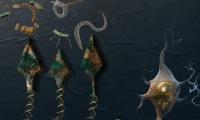ANCIENT MIGRATIONS DICTATE MODERN RISK FOR MULTIPLE SCLEROSIS
How an international research team used ancient DNA to unravel the evolutionary history of multiple sclerosis.
Research led by scientists at the Universities of Cambridge, Oxford and Copenhagen and published in Nature reveals the evolutionary origins of multiple sclerosis (MS), a scientific breakthrough that throws substantial insight into the genetic architecture of this disease and potentially other autoimmune diseases. This study into MS also changes our view of the causes of the disease and has implications for the way in which it is treated.
In the scientific journal Nature, a paper entitled Elevated Genetic Risk for Multiple Sclerosis Originated in Steppe Pastoralist Populations, which is one of four detailed papers published by the same group simultaneously, draws on ancient DNA profiles to reveal that a major migration event 5,000 years ago introduced special variants of genes into the population of Northwestern Europe. These new variants provided an advantage to the individuals that carried them at the time, likely by providing protection against infectious diseases, but today increase the risk of developing MS. The study involved DNA research, archaeology, and medical science to trace the evolution of this disease back in time.

The researchers reveal that the migration of pastoralist herders from the Pontic Steppe into Europe brought genetic variants, which in a modern environment increase the risk of developing MS. These variants were, however, advantageous in the past, because they protected the herders against pathogens which their domesticated animals exposed them to. Because the migration happened primarily into northern Europe, this is where the modern risk of MS is highest today.
To show this, the team compared the ancient DNA data to the UK Biobank, a very large modern biobank of hundreds of thousands of individuals living in Britain. Dr. William Barrie, a postdoc at the University of Cambridge and expert in computational analysis of ancient DNA, who is a co-author of the paper, said: “These results astounded us all, and provide a quantum leap in our understanding of the evolution of this disease and other autoimmune diseases. To be able to link so intimately how the lifestyles of our ancestors impact modern disease risk makes clear the great extent to which we are the recipients of ancient immune systems in a modern world. This study is a great example of the impressive outcomes achievable when different disciplines like DNA research, archaeology, and medical science join forces, and would not be possible without the huge genetic datasets which have become available in recent years.”
RISK GENE VARIANTS WAS AN ADVANTAGE
MS is an autoimmune disease in which the body’s own immune cells attack the brain and spinal cord. Looking at a world map of the distribution of MS, Northwestern Europe, including Scandinavia, has the highest prevalence, with around twice as many cases per 100,000 inhabitants compared to much of Southern Europe.
A detailed explanation to account for this phenomenon has so far eluded medical science, partly because it was not possible until now to trace MS back in time or determine its geographical origin.
Now, however, scientists have begun to answer this question in: Elevated Genetic Risk for Multiple Sclerosis Originated in Steppe Pastoralist Populations – one of the four scientific Nature articles that draw on a dataset of ancient DNA profiles obtained from analyses of archaeological bones and teeth from Europe and Western Asia.
Essentially, Elevated Genetic Risk reveals that many MS genetic risk variants entered into Scandinavia and the rest of Northwestern Europe around 5,000 years ago, and have been there ever since.
This happened in connection with a major migration event in which Yamnaya herders and their descendants, who originally inhabited the Pontic Steppe, moved west into Europe.
The risk gene variants that these people carried with them impact the immune system and when interacting with environmental and lifestyle factors, they increase the risk of developing MS in present-day individuals.
During their migration, the Yamnaya mixed with local farmers and when these admixed people arrived in Scandinavia and the rest of Northwestern Europe, they rapidly displaced much of the original local populations. Elevated Genetic Risk demonstrates that the genetic legacy of this migration and admixture persists in present-day inhabitants of this region.
The article goes on to explain that the Yamnaya migration went northwards and hence did not leave as large a genetic footprint in Southern Europe, where the statistical risk of MS is far lower than in Scandinavia and the rest of Northwestern Europe.
Moreover, the research team presents evidence that the MS risk variants actually provided a distinct advantage to the Yamnaya and their descendants, undergoing a process known as positive selection. The Nature article provides evidence that that advantage might have been due to the “zoonosis hypothesis”, which is roughly as follows:

The Yamnaya kept cattle and sheep, which exposed them to a number of zoonoses, which are diseases transmitted from animals to humans. The genetic risk variants may have arisen among the Yamnaya as they protected them against certain zoonoses and other infectious diseases. Ultimately, this meant that the individuals who had these genetic variants had a greater chance of survival and of producing offspring.
MS was the first disease Barrie and his colleagues looked for in the ancient material, but it will very likely be possible to conduct similar studies of a number of other diseases, he believes: ‘To do so, we have to be able to compare the ancient DNA with genetic data from present-day individuals that have identified genetic risk variants associated with a particular disease. If we can detect present-day risk variants for that disease in ancient material, we can then follow the evolution of the disease back in time.’
Along the way, the MS study has come to serve as a proof-of-concept in demonstrating that the large ancient human genome data sets, combined with analyses of present-day DNA and input from a number of other research fields, actually serve as a scientific precision tool capable of providing new insights into diseases.
‘The MS study gives us insights into the genetic architecture and the evolutionary mechanisms underlying the present-day risk profiles that are increasing our understanding of a number of diseases,’ Jan Egebjerg, Research Director at the Lundbeck Foundation, explains.
NEW VIEW OF MS
The new insights into the genetic factors behind MS are helping to demystify the disease, which is crucial, stresses Professor Lars Fugger, a co-author of Elevated Genetic Risk.
‘This is very important from the perspective of both patients and doctors. Because it means that we can do away with the conventional perception of MS, which defines the disease in terms of the impairments it causes, and instead understand and seek to treat MS for what it actually is: the result of a genetic adaptation to certain environmental conditions that occurred back in our prehistory and which has endured in our DNA, even though the environmental conditions have changed hugely in the time between then and now,’ Professor Fugger explains.
For more than three decades, as a professor and consultant physician at John Radcliffe Hospital, University of Oxford, Professor Fugger has been conducting research in MS and treating patients with immune-mediated disorders.
So far, 233 MS-genetic risk variants have been mapped. The findings presented in Elevated Genetic Risk show that many of these genetic variants provided protection against zoonotic and other infectious diseases, as described by the zoonoses hypothesis, but do not indicate whether they also had adverse implications in the form of MS risk. But there is no immediate indication that they held any disadvantage at that time, Fugger explains:
‘The situation today is different because the diseases these variants originally provided protection against are no longer as big a problem as they likely were then. Because in the intervening millennia, we have antibiotics, vaccinations and far, far higher standards of hygiene than people had thousands of years ago. Thus, the risk genes are now “miscast” in terms of their original biological role.’
Science so far has ‘only an incomplete understanding of why individuals develop MS’, Astrid Iversen explains.

A professor of virology and immunology at the University of Oxford, she is another co-author behind Elevated Genetic Risk. Her research concerns the evolutionary processes in the development of the human immune response to challenges from pathogens, meaning the bacteria and viruses that cause disease. Based on archaeological DNA, Professor Iversen is also investigating how pathogens interacting with environmental and lifestyle factors ever since the Last Ice Age have impacted the immune system of present-day individuals and their genetic susceptibility to certain diseases, including autoimmune diseases like MS, which have been on the rise over the last 50 years.
‘The selection process involving the human immune system is ongoing, meaning it is also happening right now,’ explains Professor Iversen, adding:
‘The individuals who have immune system genes that allow them to fight off the combination of infectious diseases they are exposed to in life will have children who pass on those same immune system genes. This is why the immune system in all present-day individuals is also, genetically speaking, the product of selection processes our ancestors underwent. But because we now lead very different lives to those of our ancestors in terms of hygiene, diet, medical treatment options for, for example, some parasitic diseases, as a result of our evolutionary history, we may, in some respects be more susceptible to certain diseases than our ancestors were, including autoimmune diseases such as MS.’
Professor Fugger comments that the new discoveries in the field of MS research also hold some promise for future treatment. ‘MS is an autoimmune disease, and a lot of the drugs we currently use to treat it target the immune system. The downside is that we risk suppressing the immune system so effectively that patients are less well equipped to fight infections. What we need is an approach whereby we can gradually learn from more studies on the genetic background of MS how to ‘recalibrate’ the immune system in patients. This would allow their immune system to play an active role in suppressing the disease.
‘While that is not just around the corner, it is still what we should be aiming for in terms of research,’ adds Fugger.

Part of the theme